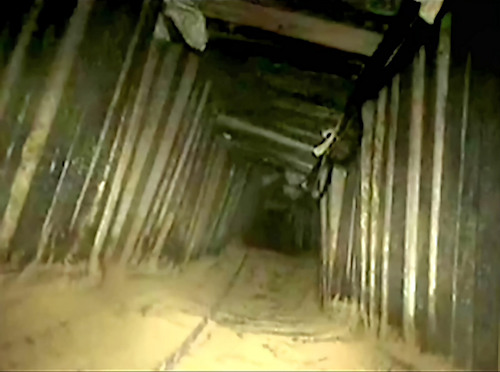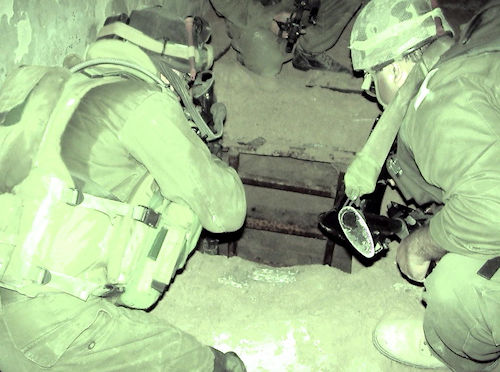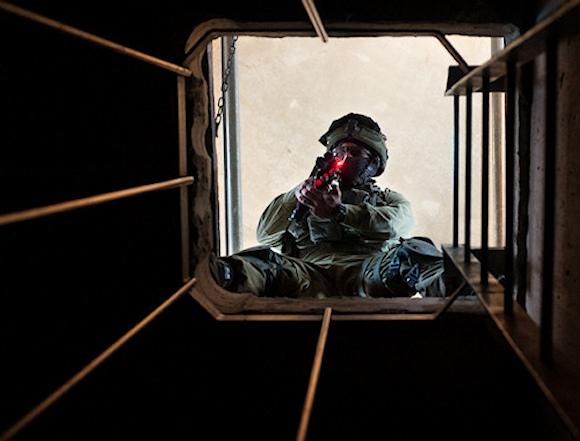As the ground offensive against Hamas proceeds along the Gaza Strip, the Tsahal forces must deal with the danger coming from the tunnels and tunnels which, as is known, fragment the subsoil of that territory. Several collapsed under heavy bombing in the north of the Strip and Gaza City, as they were subjected to targeted attacks, as ammunition depots or operational bases for Hamas military leaders. But it was only a small part.
It is known that i 1300 tunnels, some located up to 70 meters deep underground of the entire Strip (for an estimated total of 500 km of network), they represent a real community parallel to the one on the surface, which was confirmed with the testimony of a hostage freed a few days ago1. The web of tunnels and compartments equipped with foodstuffs, water, medicines, fuel, as well as ammunition and alarm and communication systems, is so large, structured and defended as to impose a redefinition of operational tactics even on the IDF, which knows and fears this underground enemy, created and grown thanks to the lavish foreign funding destined, and then diverted, to schools and hospitals in Gaza, and to the help of smuggled material, coming for years from the crossings and tunnels with Egypt.
It has been since 2014, in fact, after the operation in Gaza Mivtsa Tzuk Eitan (“Protective Edge”) 2, already against Hamas, that Israel is concentrating on studying tactics to counter the threat underground, deploying special units, trained around simulated tunnels and equipped with specific sensors, with the help of robots and dogs, in order to counter not only a terrorist threat by land but also by sea, after the discovery, in 2018, of an underwater tunnel (blue tunnel) off the coast of the Strip, which allowed Palestinian maritime commandos to leave Gaza and enter Jewish territory. After destroying it3, Israel has positioned sensors along the coastal border to detect and counter suspicious activity, while on the surface it has been using ground-penetrating radar for years, alongside techniques to measure magnetic, thermal and acoustic fingerprints, although the best tool remains the use of HUMINT and SIGINT which, in the case of last October 7, should have helped to geolocate a tunnel, given the sudden disappearance of the telephone signal of a Hamas activist, traced shortly before, precisely in the vicinity of what was then revealed to be the entrance to a tunnel.
 According to even Israeli military commentators, although feared, the underground domain however, it is still too little studied and considered by military doctrines, the law of armed conflicts and security studies, where the current classifications (defensive, offensive and commercial, i.e. for smuggling) still present several limitations because they do not capture the versatility of those infrastructures, especially cross-border ones, now capable of satisfying hitherto unknown strategic needs, as the entire hostage affair has demonstrated. First taken out of Jewish territory thanks to the tunnels, they are now held prisoner, also compromising the advance of the IDF's land operations and forcing Israel and the governments of the foreign Hamas hostages into parallel negotiations. It is not just a question of tactics, therefore, but of the dangerous shift of the entire operational axis towards considerations of a strategic and diplomatic nature.
According to even Israeli military commentators, although feared, the underground domain however, it is still too little studied and considered by military doctrines, the law of armed conflicts and security studies, where the current classifications (defensive, offensive and commercial, i.e. for smuggling) still present several limitations because they do not capture the versatility of those infrastructures, especially cross-border ones, now capable of satisfying hitherto unknown strategic needs, as the entire hostage affair has demonstrated. First taken out of Jewish territory thanks to the tunnels, they are now held prisoner, also compromising the advance of the IDF's land operations and forcing Israel and the governments of the foreign Hamas hostages into parallel negotiations. It is not just a question of tactics, therefore, but of the dangerous shift of the entire operational axis towards considerations of a strategic and diplomatic nature.
Furthermore, if it is known that the use of tunnels (from the Japanese forces in World War II, to the Viet Cong, to the Al-Qaeda forces in Mali, or those of the Islamic State in Sinai or Aleppo, then moving on to those in Afghanistan, North Korea , even Ukraine) can change the course of a conflict but its outcome rarely, in fact, provides those who exercise it with an undisputed advantage as it establishes a level of symmetry between belligerent forces with largely unequal military capabilities and equipment.
If the enemy uses the dominion of the underground, even though one may be more militarily authoritative, the ability to know and maintain control of the war scenario enormously decreases. The tactical use of the subsoil prevents, in fact, the collection of information (including knowledge of intentions, modus modus, the real offensive and defensive capabilities of the enemy), exponentially increases the surprise effect, and the fog of war it thus becomes thicker. Communicating inside the tunnels, and from inside with units on the surface, navigating and operating in an unknown or complex environment such as the underground, make the command and control of operations, as well as the prevention of terrorist actions, extremely difficult if not impossible.

The tunnels, in fact, transform the battlefield into a sphere, that is, into a multidimensional environment4, very similar to security operations in urban areas (we had already seen it in Mosul, Aleppo and now in Gaza, in fact), where the mere protection of the rear is no longer sufficient, because maintaining awareness of the situation, in the defensive phase or of neutralizing an underground adversary, having to make immediate decisions about bypassing, entering or liberating a tunnel, requires unique leadership and decision-making skills, not always the prerogative of even the special forces themselves. The operational impact of tunnel warfare, therefore, means that monitoring, mapping and sharing intelligence information in this regard are essential to anticipate threats but, equally, to operate and coordinate with the surface. And this now happens for almost all modern wars, without distinction.
Underground systems, due to their labyrinthine and non-geometric aspects, therefore require unique cognitive capabilities, with forces trained and equipped to fight and move at short distances and with little visibility, hence the requirement for high-performance night vision instruments , as well as adequate protection against loud noises, such as gunshots or explosions, which are amplified in a closed environment and therefore more destructive than those outdoors. Furthermore, the risks of IEDs remain, as well as the release of dangerous chemical substances by the enemy, which therefore requires the provision of equipment for land reclamation, rescue and extrication of the injured or intoxicated. It is therefore an extremely difficult operating environment, with the aggravating circumstance of the possible presence of civilians, such as in this case the Hamas hostages.
In practice, tunnels, even if they rarely contribute to winning wars, in fact end up absorbing significant resources from those who come across them, because they require a rethinking at a tactical and operational level, slowing down operations or complicating the protection of the forces employed. As with all complex threats, the use of the subsoil by the enemy requires unique skills, doctrine and solutions, some of which have already been acquired by the mining industry and engineering, both for low frequency radio communication, as well as the use of unmanned robots for land reclamation, or the use of material, such as infrared viewers and ropes, for the movement and rescue operations of wounded or prisoners.
 Improving situational and environmental awareness is critical to the success of any military campaign. Even more so in this case. Anticipating future trends of threats in the underground domain also means anticipating the evolution of tactics between states and non-state actors, which are increasingly numerous in today's conflict contexts. Underground warfare has in fact undergone significant changes over the last century, with an acceleration due to guerrilla conflicts, with the adoption and adaptation of previous tactics to needs, objectives and modus modus of terrorist groups and non-state actors, such as Hamas, Hezbollah and the self-styled Islamic State, to remain in the Middle Eastern region.
Improving situational and environmental awareness is critical to the success of any military campaign. Even more so in this case. Anticipating future trends of threats in the underground domain also means anticipating the evolution of tactics between states and non-state actors, which are increasingly numerous in today's conflict contexts. Underground warfare has in fact undergone significant changes over the last century, with an acceleration due to guerrilla conflicts, with the adoption and adaptation of previous tactics to needs, objectives and modus modus of terrorist groups and non-state actors, such as Hamas, Hezbollah and the self-styled Islamic State, to remain in the Middle Eastern region.
Furthermore, warfare in the underground domain requires careful strategic evaluations due to the symmetry that is created between the enemies. Not least, in fact, in a context such as the current one of great competition between powers, albeit often medium or regional, it is necessary to identify the way in which underground warfare interacts with other domains, such as the terrestrial one (war and urban guerrilla warfare), air and even naval. To successfully face this threat, its perception should therefore move from simply tactical to seriously strategic, as has been painfully learned in recent weeks with the civilian hostages, Israeli and foreign, of Hamas.
3 E. Abu Jahal, “Israel announces destruction of underwater Hamas tunnel,” To the Monitor, June 19, 2018.
4 British Army Review, Special Report, Urban Operations, Vol. 1, Winter 2018, pp. 104-115.
Photo: IDF / web












